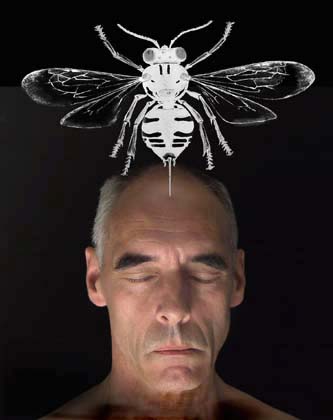| Paraspiration |

|
Because Theo Voorzaat's painting "The Illusion" adorned the cover of the "Journal of the Royal Zeeland Scientific Society" (Vol. 11.2), I sat down and read two of this publication's well documented articles, one of which dealt with artist colonies in Zeeland across the ages while the other elaborated on bee and wasp populations.* One of the rarest wasps, Pseudogonalos hahni, skims the greenery like a bomber aircraft to drop its eggs, causing them eventually to end up in the stomach of some unlucky caterpillar, which in turn needs to have been infected first by a stealth wasp of the genus Ophion, the larva of which devours the caterpillar from inside. With a bit of luck the larva will also gobble up the egg the caterpillar had previously swallowed, and which houses a larva which when the time is right starts doing the same to the Ophion larva as the latter does to the caterpillar. For the sake of self-preservation I hasten to add that my thoughts are currently sponging off this phenomenon, but isn't it amazing how much effort it takes both to captivate and convince using the proper representation? Of course a population is not the same as a colony and proliferation hardly the same as inspiration, while being a parasite is definitely something other than emulating. But if you have an eye for parallels and a stomach for alternative scenarios of the macabre variety - although I should add here that nature does not operate any values in this respect, so it's all our fault for complicating things - this chance metaphor in Zeeland strikes a pretty distinctive chord, wouldn't you agree? Although I can reassure you to a degree if you were to wonder which metaphor applies to whom, bearing in mind that the application of human behaviour to confer deeper meaning upon animal conduct is standard practice. * Red alert for bee and wasp fauna in Zeeland. |